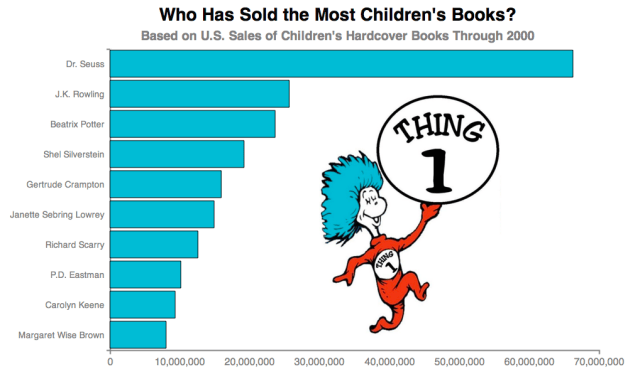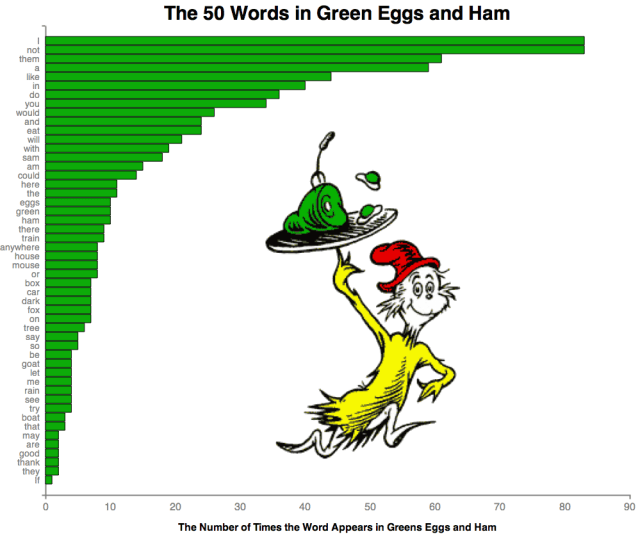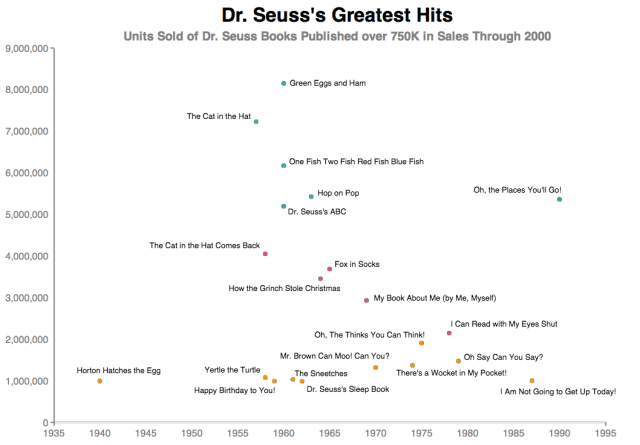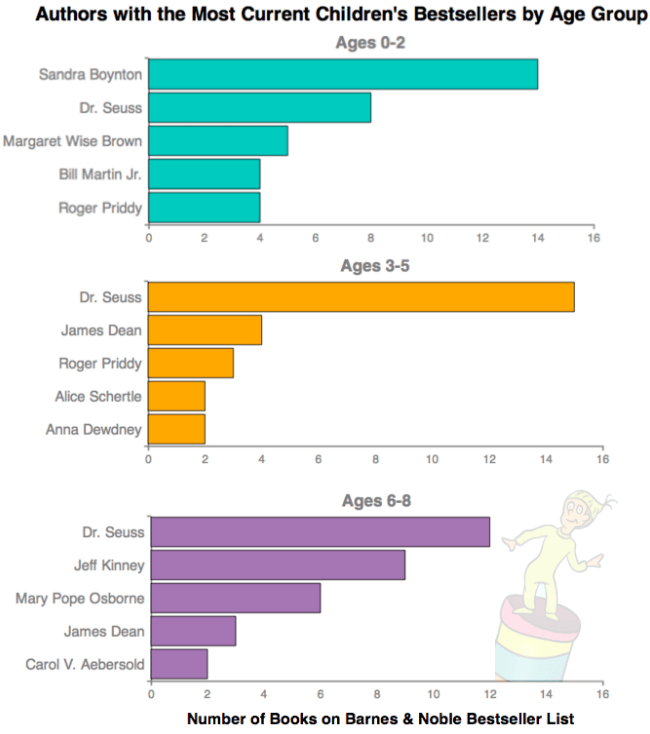Nearly twenty-five years after his death, Dr. Seuss continues to dominate the world of children’s books to an astonishing degree.
Today, one in four children’s first book is one penned by Theodor Seuss Geisel (Dr. Seuss’s given name). The Cat in the Hat, Green Eggs and Ham, and How the Grinch Stole Christmas!, all published prior to 1970, remain among today’s bestselling children’s books. The Grinch might have stolen Christmas, but Geisel stole all our hearts.
In 2001, Publishers Weekly released a list of the bestselling hardcover children’s books of all time in the United States. This was the last time a comprehensive list was produced. By total units sold (66 million) and number of books in the top 100 (16), Geisel is on top by a longshot.
If the data were current, it is likely that J.K. Rowling, who conjured Harry Potter, would be creeping closer to Seuss in terms of units sold. Still, given the brisk pace of sales for Seuss books, it is doubtful she will ever catch him.

Dan Kopf, Priceonomics; Data: Publishers Weekly
***
Geisel’s rise is a story of the triumph of simplicity.
By the mid 1950s, Geisel had achieved a fair amount in his career, but nothing like what was to come. He had been a successful advertising man, who wrote and illustrated cartoons for major bug spray and brewery marketing campaigns. He had also published thirteen children’s books under the Dr. Seuss pen name, which he started using in 1927 as a joking reference to his father’s wish for him to become a doctor. The books had received critical acclaim, but only modest sales.
Around the same time, parents and educators began to fear that American children were falling behind their European counterparts in terms of their educational achievement. They watched too much TV, and children’s books were too boring to captivate them. In 1955, English professor Rudolf Flesch published the influential book Why Johnny Can’t Read, which pilloried the children’s literature of the time and promoted the use of phonics to teach reading and writing. Concerns about the poor state of early childhood education even became a national security concern.
William Spaulding, the director of the education division at Houghton Mifflin, was a believer in Flesch’s criticisms.
Spaulding approached Geisel with a challenge. Spaulding had identified 348 words that first graders should know, and he asked Geisel to write an imaginative and captivating book using only those words. Geisel initially considered the challenge “impossible and ridiculous”, but he decided to try. The resulting book, The Cat in the Hat, only used 236 different words, but those 236 words started a phenomenon.
The Cat in the Hat was published in 1957 and became one of the bestselling children’s books of all time. Within three years, the book had already sold one million copies. Today, more than fifty years after publication, it remains a bestseller.
Emboldened by the success of The Cat in the Hat’s parsimony, Geisel took this austerity of words even further. One of his publishers bet him that he could not write a book using just fifty words. Geisel won the bet and, in the process, wrote another iconic children’s book, Green Eggs and Ham.

Dan Kopf, Priceonomics; Data: Green Eggs and Ham
From 1957 to 1965, with his new, spare style, Seuss had an unrivalled run of success in early childhood writing. During this period, he wrote eight of the 35 bestselling children’s books of the 20th Century: classics like The Cat in the Hat, The Cat in the Hat Comes Back, How the Grinch Stole Christmas!, One Fish Two Fish Red Fish Blue Fish, Green Eggs and Ham, and Hop on Pop.
The following chart displays the sales of each book Seuss wrote that had 750,000 sales by 2001.

Dan Kopf, Priceonomics; Data: Publishers Weekly
***
Perhaps the most amazing aspect of Geisel’s success is its persistence. While most popular children’s books fade after peaking for a number of years, more than twenty years after his death, Geisel’s work remains incredibly popular. In fact, sales appear to be on the rise. In 2013, 4.8 million Geisel books were sold, a 50% increase on the 3.2 million that were sold in 2010.
In order to quantify this continued dominance, we collected data from Barnes and Noble’s top 100 bestsellers lists for the following age groups: 0-2 year olds, 3-5 year olds and 6-8 year olds. Of the 300 books on these lists, Geisel authored 35 of them. The author with second most bestsellers is Sandra Boynton, of Moo, Baa, La La La! fame, with fourteen. The following chart shows the number of bestsellers for the top five authors in each age group.

Dan Kopf, Priceonomics; Data: Barnes & Noble
What explains Dr. Seuss’s continued popularity?
It is probably no coincidence that the pinnacle of Seuss’s career coincided with the baby boom. Louis Menand of the New Yorker points out that the year The Cat in the Hat was released was the same year (1957) that the largest cohort of children was born in American history (4.3 million). Geisel is the Beatles of children’s literature, an institution of popular art whose place in the culture is cemented by its relationship to the country’s largest generation.
Geisel’s continued popularity is also likely a manifestation of the ingenious ways Random House, his publisher, has marketed his work. The company connects many of his books to major calendar events: Oh the Places You’ll Go for high school and college graduations. How the Grinch Stole Christmas for, you guessed it, Christmas. The Lorax for Earth Day. Horton Hears a Who for the newly created Anti-Bullying Day.
Random House has also continued to publish Dr. Seuss’s unfinished works posthumously, which keeps Seuss relevant. Seven new books have been published after his death, including 2015’s What Pet Should I Get, which debuted at number one on the New York Times Children’s Books Bestseller list.
Seuss also benefits from the relative timelessness of children’s literature. While only one of the authors with more than one book in the Barnes and Noble adult fiction bestsellers list is by an author not working today, Harper Lee, the children’s books bestsellers lists are littered with names of artists that haven’t produced new work in decades. Authors like Geisel, Bill Martin, Jr. (Brown Bear, Brown Bear, What Do You See), Margaret Wise Brown (Goodnight Moon) and P.D. Eastman (Are You My Mother) still have considerable readership.
Children’s literature is different because, up to a certain age, the main consumer, the child, is at the mercy of his or her parents. For the parent, reading children’s books is an exercise in nostalgia. A chance to revisit the works that you were devoted to as a child.
As long as there are parents who remember loving Thing One and Thing Two, Yertle the Tertle, Mr. Sneelock and Sam-I-Am, Dr. Seuss books will keep flying off the shelves.
Our next post chronicles the search for a paleo sleep schedule. To get notified when we post it → join our email list.
![]()
This post was written by Dan Kopf; follow him on Twitter here.



